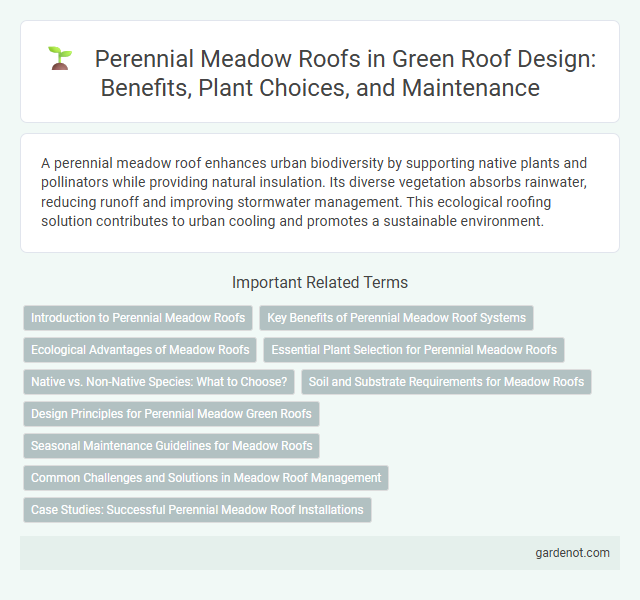A perennial meadow roof enhances urban biodiversity by supporting native plants and pollinators while providing natural insulation. Its diverse vegetation absorbs rainwater, reducing runoff and improving stormwater management. This ecological roofing solution contributes to urban cooling and promotes a sustainable environment.
Introduction to Perennial Meadow Roofs
Perennial meadow roofs consist of diverse, drought-resistant plants that create a self-sustaining ecosystem on buildings. These roofs enhance biodiversity, improve air quality, and provide natural insulation, reducing energy costs. By incorporating native perennial species, perennial meadow roofs require minimal maintenance while supporting urban wildlife habitats.
Key Benefits of Perennial Meadow Roof Systems
Perennial meadow roof systems enhance urban biodiversity by providing habitat for pollinators and birds, while improving stormwater management through increased water retention and reduced runoff. These roofs contribute to thermal regulation, lowering building energy costs by insulating against temperature extremes. They also extend roof lifespan by protecting the underlying membrane from UV damage and mechanical wear.
Ecological Advantages of Meadow Roofs
Perennial meadow roofs enhance urban biodiversity by providing habitat for pollinators such as bees and butterflies, supporting local ecosystems and promoting species diversity. These roofs improve air quality through natural filtration and mitigate urban heat island effects by retaining heat and reducing building cooling loads. Their deep-rooted vegetation stabilizes the substrate, enhances stormwater management by absorbing rainfall, and reduces runoff, contributing to sustainable urban water cycles.
Essential Plant Selection for Perennial Meadow Roofs
Essential plant selection for perennial meadow roofs includes native grasses such as Festuca rubra and Deschampsia cespitosa, which offer drought tolerance and low maintenance. Incorporating a diverse mix of flowering perennials like Echinacea purpurea and Achillea millefolium supports pollinator habitats and enhances biodiversity. Proper plant selection ensures resilience to local climate conditions and contributes to the long-term sustainability of the green roof ecosystem.
Native vs. Non-Native Species: What to Choose?
Selecting native species for a perennial meadow roof supports local biodiversity, enhances ecological resilience, and reduces maintenance by adapting naturally to the area's climate and soil conditions. Non-native species may offer unique aesthetic appeal or specific functions but often require more resources and can disrupt local ecosystems. Prioritizing native plants aligns with sustainable green roofing practices and promotes long-term environmental benefits.
Soil and Substrate Requirements for Meadow Roofs
Perennial meadow roofs require a well-draining substrate with a depth of at least 12-20 cm to support diverse plant species and ensure root development. The soil mix must balance organic matter and mineral components, typically containing 30-50% organic content to retain moisture without causing waterlogging. Proper substrate composition enhances nutrient availability, promotes biodiversity, and improves the roof's insulation and stormwater retention capabilities.
Design Principles for Perennial Meadow Green Roofs
Perennial meadow green roofs prioritize plant diversity, drought tolerance, and deep-rooted species to enhance resilience and ecological benefits. Design principles emphasize layered vegetation structures, proper substrate depth, and efficient water retention to support native meadow ecosystems. Integrating these features optimizes green roof performance, biodiversity, and stormwater management.
Seasonal Maintenance Guidelines for Meadow Roofs
Seasonal maintenance for perennial meadow roofs involves regular inspection and tailored care during each season to support plant health and biodiversity. In spring, remove accumulated debris and assess plant vitality, while summer requires monitoring for irrigation needs and controlling invasive species. Autumn focuses on trimming overgrown vegetation and preparing the meadow for dormancy, with winter maintenance primarily addressing snow load management and preventing soil erosion.
Common Challenges and Solutions in Meadow Roof Management
Perennial meadow roofs often face challenges such as weed invasion, uneven plant establishment, and nutrient imbalances that affect long-term vegetation health. Effective solutions include regular maintenance practices like targeted hand-weeding, selective mowing to promote diverse species growth, and tailored soil amendments to optimize nutrient levels. Implementing adaptive irrigation strategies and monitoring can further enhance plant resilience and overall ecosystem stability on meadow roofs.
Case Studies: Successful Perennial Meadow Roof Installations
Case studies of successful perennial meadow roof installations highlight their benefits in urban biodiversity and stormwater management, with projects like the Chicago City Hall and the Vancouver Convention Centre showcasing thriving native plant species and enhanced ecological habitats. These installations demonstrate reduced urban heat island effects and improved building insulation, contributing to energy efficiency. Monitoring data from these sites reveal increased pollinator activity and significant rainwater retention, establishing perennial meadow roofs as sustainable green infrastructure solutions.
Perennial meadow roof Infographic

 gardenot.com
gardenot.com